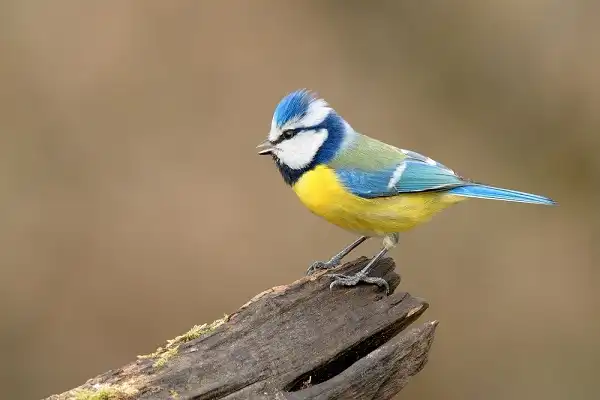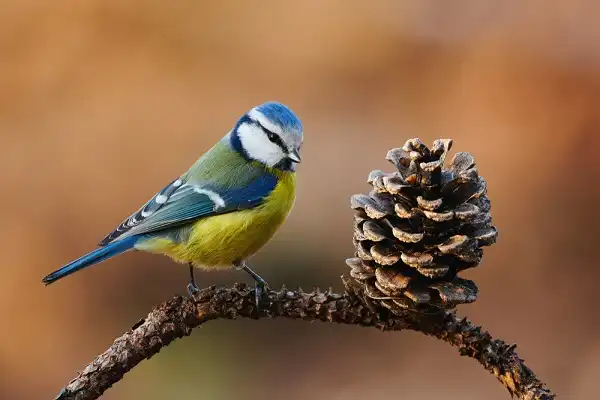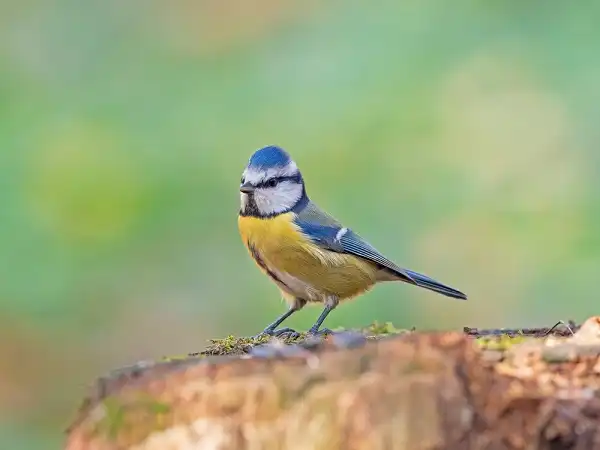Hold onto your hats, because you’re about to learn everything there is to know about the common blue tit – a cheerful little bird that brightens up gardens and parks all around the world. This article will explore the anatomy, behavior, and migration patterns of this fascinating species, providing insight into their importance as pollinators and seed dispersers in many ecosystems. Get ready to discover more about these adorable feathered friends!

Blue Tit Description
The Blue Tit (Cyanistes caeruleus) is a small and lively bird that can be found in gardens, parks, and woodlands all around the world. They are recognizable by their bright blue feathers, white underbelly, and yellow flashes on their wings. They have active behavior, engaging in acrobatics to search for food; they build neat cup-shaped nests out of twigs with fluff or moss inside and lay up to 10 eggs at a time.
Blue Tit Habitat
The Blue Tit is an adaptable bird species and can be found in a variety of habitats, including woods, gardens, parks, and even urban areas. They are most commonly seen in deciduous forests where they can feed on insects and berries. They also inhabit coniferous forests, meadows, and scrubland. In urban areas, they seek out trees and gardens with plenty of food sources such as bird feeders and flowering plants. Blue Tits prefer to nest in tree crevices, holes in walls or posts, hollow branches, or even old nests left by other birds. During the winter months, they often migrate southward in search of warmer climates with more abundant food sources. Blue Tits play an important role in their ecosystems as pollinators and seed dispersers; feeding on fruits such as berries, nuts, seeds, and nectar from flowers helps spread those plants further within their environment while providing them with nutrition.
Blue Tit Diet
The Blue Tit has a varied diet, depending on the season and availability of food sources. During the summer months, they mainly feed on insects such as spiders, caterpillars, beetles, and aphids; they also consume fruits such as berries, nuts, and seeds. In autumn they often switch to nuts and seeds, while in the winter months, they feed mainly on nectar from flowers. They also visit bird feeders and bird tables that are supplied by humans in their environment. Blue Tits have adapted to take advantage of human-supplied food sources which provide them with important nutrition during the colder months when insect populations are low. Blue Tits play an important role in ecosystems by helping to pollinate plants and spread their seeds further than they would be able to on their own. This helps keep ecosystems healthy and provides habitats for other wildlife species. When blue tits feed on fruits, they swallow them whole or break them into smaller pieces which helps disperse the seeds away from the parent plant. They also help spread pollen between flowers when foraging for nectar, aiding plants in reproducing successfully.

Blue Tit Size
The Blue Tit is a small bird species that ranges from 12 to 14 cm in length, with an average wingspan of 20-22 cm. They have slim bodies and short tails, which they use to balance while flitting between branches. Male Blue Tits can be distinguished from females when viewed closely; males will generally have darker blue coloration on their crown and face than female birds. In addition to their distinctive coloring, adolescent male Blue Tits also grow larger crest feathers than adult females during springtime as part of their mating ritual. This helps them attract potential mates in their search for a partner. Overall, the Blue Tit’s size makes it well adapted for life in the ever-changing environments across Europe and Asia where it resides; this enables them to take advantage of different food sources such as insects, seeds, nuts, nectar from flowers, and even human-supplied bird feeders should they be available.
Blue Tit Lifespan
The average lifespan of a Blue Tit is around 4 to 7 years in the wild, although some can live up to 10 years or more if they are able to find adequate food and avoid predators. However, autumn months can be dangerous for Blue Tits as there is an increased risk of predation and harsh weather conditions that can make foraging for food more difficult. The lifespan of a wild bird also depends on its ability to find safe nest sites and food sources during its migration periods. In captivity, Blue Tits have been known to live much longer than those in the wild, often reaching double digits in age. This is because they have access to reliable food sources and protection from predators or inclement weather. Captive birds are also less likely to succumb to diseases or parasites which can shorten their life expectancy in the wild. They are also beneficial for bird feeders as their presence helps draw other wildlife species such as sparrows and finches into local gardens where people can enjoy watching them close up. As such, humans can contribute towards increasing the lifespan of Blue Tits by providing them with supplementary nutrition during times when natural resources are scarce.
Blue Tit Behavior
The Blue Tit has a lively and inquisitive nature and can often be seen flitting through the branches of trees in search of food. They are often seen alone or in small groups, as they tend to be territorial during the breeding season. During the winter months, however, large flocks may gather in areas with plenty of food sources. Blue Tits have wide repertoires of vocalizations that are used for communication between adults within a flock or during mating rituals. Common calls include a high-pitched ‘tsee’ sound as well as an alarm call that is made up of three notes repeated twice. Males may also produce song flights to attract potential mates during the breeding season. In addition to their vocal communications, Blue Tits use visual displays such as bowing and wing-flicking when interacting with other individuals in the flock or with potential mates. These displays help them establish their status in the group hierarchy or attract a mate before breeding begins. During courtship rituals males will perform song flights and bow toward females while trying to pass food items back and forth between them; this helps establish trust and increases chances for successful mating pairs during nesting periods. As a species that relies heavily on insect populations for survival, it is important for Blue Tits to find adequate resources both inside and outside their home range; this means being able to adapt to changing habitats throughout Europe and Asia where they live all year round.

Blue Tit Speed
Blue Tits are fairly agile fliers, able to make tight turns and maneuver quickly through dense foliage. They often fly at an average speed of around 10–35 miles per hour (16–56 km/h) depending on whether they are in flight or gliding. During migration, they may reach speeds of up to 60 mph (97 km/h), but this is usually only done when there is a strong tailwind behind them. When foraging for food, Blue Tits have been known to hover briefly in mid-air before diving down onto their prey. This has been observed in both wild and captive populations and suggests that they are capable of using the wind to their advantage while hunting. They also use their agility to escape predators such as hawks and cats, which can be difficult since these animals can fly faster than Blue Tits in most cases. Blue Tits’ acrobatic abilities are a result of their small size and lightweight; these traits allow them to move quickly and efficiently while still being able to change direction quickly if necessary. Their feathers also play an important role in maintaining speed as they reduce friction when flying through the air and enable Blue Tits to glide easily with minimal effort. Overall, Blue Tits are fast and agile birds that rely heavily on their speed and agility to survive in the wild. By taking advantage of wind currents and being able to quickly change direction, they are able to find food sources efficiently while also avoiding predators. In addition, their small size makes them more aerodynamic than larger species which helps them maintain speed during flight.
Blue Tit Hunting
Blue Tits are mainly insectivores, feeding on the larvae of moths and butterflies, caterpillars, spiders, aphids, flies, and other small invertebrates. They will also consume berries and other fruits when available. To catch their prey, Blue Tits use a combination of perching and hovering as they search for food in bushes or trees. They can be seen darting from one spot to another as they hunt for insects, using their bills to pick them up while in mid-air. They are also skilled at catching fast-moving targets such as dragonflies or flying ants; this is done by diving quickly toward their prey before snatching it with their bill. This technique requires speed and agility, making it one of the most impressive hunting behaviors in birds. Blue Tits are also known to use their feathers as a kind of ‘net’ when chasing flying insects; they spread out their wings and tail feathers while on the move which allows them to capture several at once. This is an efficient way of hunting which requires less energy than flapping their wings constantly. Blue Tits are known for being very active hunters and can be seen searching for food day and night, often returning to their nest with multiple prey items in their bills.
Blue Tit as Pets
Though they are not often kept as pets, Blue Tits can make wonderful companions with the right care and attention. They are relatively easy to train and will usually take food from their owners’ hands when offered. These birds also enjoy being handled and will happily sit on someone’s shoulder or lap for extended periods of time. In addition to providing companionship, Blue Tits can be trained to perform tricks such as retrieving items or flying through hoops. They have even been known to mimic simple human words upon hearing them repeated enough times. The high intelligence of these birds makes it possible for them to learn a variety of complex behaviors which is why they are sometimes used in bird shows. To keep Blue Tits as pets, it is important to provide them with a large cage that allows for plenty of flight space and some small branches so they can climb. Toys should also be provided to keep the birds entertained as well as some perches where they can rest. Fresh water and a variety of nutritious foods such as mealworms or other insects should also be available at all times.

Conclusion
Blue Tits are a remarkable species of birds. They have adapted well to their changing environment and have developed advanced hunting techniques which make them one of the most successful bird species in the world. These birds can also be kept as pets with proper care and attention, providing companionship and entertainment for those who choose to keep them. With their bright colors and lively personalities, Blue Tits are truly a sight to behold!
Frequently Asked Question

